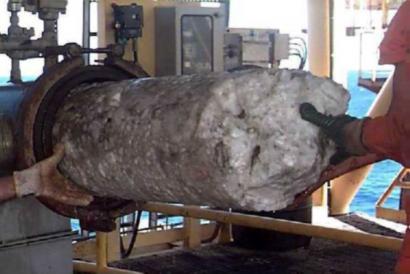In gas/water or gas/oil/water systems, any change of pressure or temperature, will place a pipeline at risk of forming line-blocking, hydrates (light hydrocarbons and water which freeze in a snow like form) within the stream - see photo. A preferred method of combating hydrate formation is to depress the freezing point of the stream below the anticipated temperature that the flowing liquid is likely to reach. Both methanol and glycol are used for this purpose, but methanol has the added ability of being able to break down hydrate crystals which have already formed. Continual monitoring of the delivery of the inhibitor provides a traceable record of the effectiveness of the inhibitor program relative to the quality of the well stream.
Based on measured effectiveness, desired dosage amounts are prescribed and achieved through varying stroke count and rate on an injection pump system. The intermittent flow of methanol is only measurable with positive displacement meters which are accurate despite the start/stop flow profile. To accurately sum the small injected amounts, a high resolution meter with hundreds of pulses per cc is needed to not miss a drop and provide quick, repeatable verification of the flow.
Max equipment specified:
The Model P213 is used to accurately measure instantaneous injection rates from 1 - 1500 cc/minute. For instantaneous rates above 1500 cc/minute the Model P214 is the recommended meter. A high resolution transmitter (1000 pulses/cc – Model P213) is required because of the low flow and sudden on-off conditions associated with odorant injection pumps. If you would like a quote for a similar project, please let us know.


